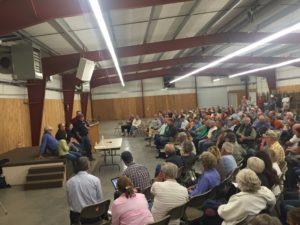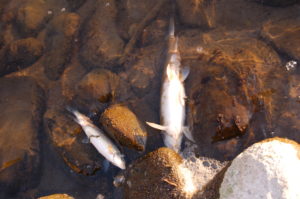Uncategorized
Livingston meeting on Yellowstone fish kill, closure draws hundreds
Published
8 years agoon
Posted By
Outlaw Partners
By Amanda Eggert EBS Associate Editor
LIVINGSTON, Mont. – Montana Fish, Wildlife and Parks personnel on Wednesday fielded questions at the Park County Fairgrounds about the parasite killing tens of thousand of mountain whitefish, and what government resources are available to ease the economic strain upon an area that draws its lifeblood from the river.
Approximately 400 people attended the meeting, many of them full of questions about the parasite and frustrated by what has been perceived as a lack of government responsiveness to the human impact of the closure.
Fish, Wildlife and Parks spokeswoman Andrea Jones opened the meeting with a summary of what the agency knows about the parasite responsible, Tetrascapula bryosalmonae, and repeated the agency’s Aug. 19 message to the public: a 183-mile stretch of the Yellowstone River and its tributaries will remain closed for the foreseeable future.
Emigrant to Springdale appears to be hardest hit by the fish kill, Jones said. The closure stretches from the Yellowstone National Park boundary just outside of Gardiner to the Highway 212 bridge in Laurel. In addition to the tens of thousands of mountain whitefish that are believed to have died, a number of other species have succumbed to the parasite, which causes proliferative kidney disease.
Fish, Wildlife and Parks has confirmed that at least one rainbow trout, one Yellowstone cutthroat trout, one sculpin and one long-nosed sucker have died from exposure to the parasite. Dozens more trout have been sent to a lab in Bozeman for analysis—a process that takes a minimum of two days.
Jones reemphasized that this summer has been unusually tough on fish due to warm water—daytime high temperatures for the river have frequently reached 70 degrees—and low flows. She explained that ideal temperatures for trout and whitefish are in the mid-50s F and the Yellowstone is running just 280 cubic feet per second above its all-time low from records dating back 120 years.
Officials don’t expect those conditions to ease in the near future. Sam Sheppard, the Region 3 supervisor for the agency, said the Yellowstone’s water temperatures don’t typically come down until October or November, and it won’t see increased flows until March.
One man in attendance looked for reassurance in the form measurable conditions—like mortality rates dropping to a pre-established level or water temperatures reaching a certain point—that would merit the reopening of the Yellowstone, or even upstream sections of its tributaries.
Sheppard said no such standards have been established and the agency has intentionally kept the closure fluid in an adaptive management approach.
One audience member said she appreciates FWP’s response to the natural resource protection component of the fish kill, but expressed frustration that there hasn’t been more of a coordinated response from other government agencies.
“I run a ranch in Emigrant [and] we’ve had massive cancellations the past three days,” she said, adding that she knows more than 25 people who have lost their job in the past five days.
“Where is the interagency response?” she continued. “Where’s the rest of the process and the rest of the solution for those of us who can’t handle the tremendous economic disaster that is closing in?”
Sheppard said that FWP has responded to every call it’s received, but mitigating the economic impact is outside of its scope as an agency and “there’s no simple solution to the economic part of this.”
“I promise you this, we will take these messages … up to the governor’s office,” said Mike Volesky, deputy director of Fish, Wildlife and Parks. He also recommended that impacted individuals and businesses do their part by notifying their elected officials.
Dan Vermillion, the Livingston-based FWP commissioner for this district, said it’s important that impacted individuals address the issue cooperatively.
“I really hope that we look at it from a community perspective and not one of us-versus-them,“ Vermillion said.
Vermillion addressed theories pertaining to the fish kill he’s heard in recent days.


Approximately 400 people attended the meeting at the Park County Fairgrounds. PHOTO BY AMANDA EGGERT
The fish kill is not related to the native fish restoration project in Yellowstone National Park, he said. Rotenone, a piscicide that’s been applied there in efforts to reestablish populations of Yellowstone cutthroat, dissipates quickly and would have affected all fish, he said.
He also heard that there might have been seismic activity that’s created some kind of dispersal and said there’s no indication of that.
Vermillion spoke to those concerned that irrigation in Paradise Valley has contributed to low water levels. “Even if we shut off all the irrigation on the river, which is fairly minimal at this point in the summer, it would not turn this situation around,” he said.
Officials spoke about Montana’s complicated water rights—FWP does not have the authority to prevent water rights holders from drawing out of the Yellowstone and its tributaries, said Travis Horton, FWP’s region 3 fisheries manager.
Horton and Dr. Eileen Ryce, FWP’s hatchery bureau chief, fielded technical questions about the parasite and its impact upon fish.
The parasite has a complicated life cycle that requires two hosts, Ryce said. One key part of the cycle involves a bryozoan, an invertebrate animal similar to a freshwater sponge that serves as one of the hosts. Fish are the other host.
Ryce said the bryozoan releases the infective stage for fish, which becomes infected primarily through the gills. From there, the parasite travels into the bloodstream and causes kidney damage. The fish then excrete the parasite via waste products into the water, where it will infect more bryozoans and the cycle continues.
Ryce said spores of the parasite have been so prevalent in all of the fish tissues examined that it’s possible fish are dying of septic shock from exposure rather than the proliferative kidney disease. She added that the infection underway now would act like a vaccine. Fish that survive will have a strengthened immune response to future infections, she said.
When asked if FWP still believes that the parasite was introduced from another waterway via an unclean boat or waders, Ryce said the agency will likely never know when and where the parasite entered the Yellowstone. She said the agency still believes the river’s fish were not previously exposed to the parasite given how little immune response is evident in samples collected.
Fish, Wildlife and Parks is also sequencing the genome of the parasite to obtain more precise information about the particular parasite infecting Yellowstone’s fish, Horton said. He added that whitefish—which are native to Montana—tend to be very sensitive to adverse conditions like temperature stress. “They’re typically the canary in the coal mine,” he said.
Ryce said the parasite does not pose a health risk to humans, dogs and birds—but the bacteria growing on decomposing fish could adversely impact them if consumed.
One woman said her dog died after eating dead whitefish. Sheppard thanked her for giving FWP the dog to examine, and said the initial necropsy did not determine what specifically caused the dog to die. Results should be available in a couple of days, Sheppard said.
FWP’s message on collecting fish carcasses to mitigate impact to pets and wildlife was mixed. Initially, they encouraged people to collect what they could and dispose of the fish in an appropriate landfill. However, Ryce changed the recommendation during the meeting, saying obtaining accurate carcass counts would be important to the agency as they make management decisions about the closure.
The Outlaw Partners is a creative marketing, media and events company based in Big Sky, Montana.


Upcoming Events
november, 2024
Event Type :
All
All
Arts
Education
Music
Other
Sports
Event Details
Spanish Classes with World Language InitiativeThese unique, no cost Spanish classes are made possible by the contribution of Yellowstone Club
more
Event Details
Spanish Classes with World Language InitiativeThese unique, no cost Spanish classes are made possible by the contribution of Yellowstone Club Community Foundation (YCCF) and Moonlight Community Foundation (MCF). This class will focus on building a lifelong affinity for world languages and cultures through dynamic and immersive Communicative Language teaching models.
Beginner Class – Mondays and Wednesdays from 5:30-6:30 pm
Intermediate Class – Mondays and Wednesdays from 6:45- 7:45 pm
- Classes begin Oct.7, 2024 and run for 6 weeks
- Class size is limited to 12 students
- Classes are held in Big Sky at the Big Sky Medical Center in the Community Room
For more information or to register follow the link below or at info@wlimt.org.
Time
October 21 (Monday) 5:30 pm - November 27 (Wednesday) 7:45 pm
Location
Big Sky Medical Center - Community Room (2nd Floor)
Big Sky Medical Center - Community Room (2nd Floor)
Event Details
Spanish Classes with World Language InitiativeThese unique, no cost Spanish classes are made possible by the contribution of Yellowstone Club
more
Event Details
Spanish Classes with World Language InitiativeThese unique, no cost Spanish classes are made possible by the contribution of Yellowstone Club Community Foundation (YCCF) and Moonlight Community Foundation (MCF). This class will focus on building a lifelong affinity for world languages and cultures through dynamic and immersive Communicative Language teaching models.
Beginner Class – Mondays and Wednesdays from 5:30-6:30 pm
Intermediate Class – Mondays and Wednesdays from 6:45- 7:45 pm
- Classes begin Oct.7, 2024 and run for 6 weeks
- Class size is limited to 12 students
- Classes are held in Big Sky at the Big Sky Medical Center in the Community Room
For more information or to register follow the link below or at info@wlimt.org.
Time
October 28 (Monday) 5:30 pm - December 4 (Wednesday) 7:45 pm
Location
Big Sky Medical Center - Community Room (2nd Floor)
Big Sky Medical Center - Community Room (2nd Floor)
Event Details
Spanish Classes with World Language InitiativeThese unique, no cost Spanish classes are made possible by the contribution of Yellowstone Club
more
Event Details
Spanish Classes with World Language InitiativeThese unique, no cost Spanish classes are made possible by the contribution of Yellowstone Club Community Foundation (YCCF) and Moonlight Community Foundation (MCF). This class will focus on building a lifelong affinity for world languages and cultures through dynamic and immersive Communicative Language teaching models.
Beginner Class – Mondays and Wednesdays from 5:30-6:30 pm
Intermediate Class – Mondays and Wednesdays from 6:45- 7:45 pm
- Classes begin Oct.7, 2024 and run for 6 weeks
- Class size is limited to 12 students
- Classes are held in Big Sky at the Big Sky Medical Center in the Community Room
For more information or to register follow the link below or at info@wlimt.org.
Time
November 4 (Monday) 5:30 pm - December 11 (Wednesday) 7:45 pm
Location
Big Sky Medical Center - Community Room (2nd Floor)
Big Sky Medical Center - Community Room (2nd Floor)










